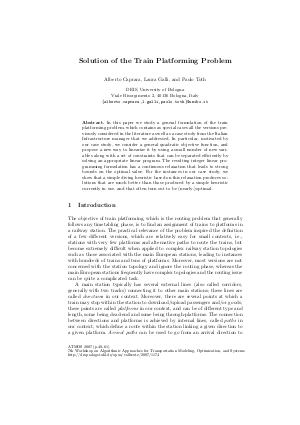04. Solution of the Train Platforming Problem
Authors Alberto Caprara, Laura Galli, Paolo Toth
-
Part of:
Volume:
7th Workshop on Algorithmic Approaches for Transportation Modeling, Optimization, and Systems (ATMOS'07) (ATMOS 2007)
Part of: Series: Open Access Series in Informatics (OASIcs)
Part of: Conference: Symposium on Algorithmic Approaches for Transportation Modelling, Optimization, and Systems (ATMOS) - License:
 Creative Commons Attribution-NonCommercial-NoDerivs 3.0 Unported license
Creative Commons Attribution-NonCommercial-NoDerivs 3.0 Unported license
- Publication Date: 2007-11-06
File

PDF
OASIcs.ATMOS.2007.1174.pdf
- Filesize: 194 kB
- 13 pages
Document Identifiers
Subject Classification
Keywords
- Train Platforming
- Train Routing
- Branch-and-Cut-and-Price
- Quadratic Objective Function
- Linearization
Metrics
- Access Statistics
-
Total Accesses (updated on a weekly basis)
0Document
0Metadata
Abstract
In this paper we study a general formulation of the train platforming problem, which contains as special cases all the versions previously considered in the literature as well as a case study from the Italian Infrastructure manager that we addressed. In particular, motivated by our case study, we consider a general quadratic objective function, and propose a new way to linearize it by using a small number of new variables along with a set of constraints that can be separated efficiently by solving an appropriate linear program. The resulting integer linear programming formulation has a continuous relaxation that leads to strong bounds on the optimal value. For the instances in our case study, we show that a simple diving heuristic based on this relaxation produces solutions that are much better than those produced by a simple heuristic currently in use, and that often turn out to be (nearly-) optimal.
Cite As Get BibTex
Alberto Caprara, Laura Galli, and Paolo Toth. 04. Solution of the Train Platforming Problem. In 7th Workshop on Algorithmic Approaches for Transportation Modeling, Optimization, and Systems (ATMOS'07). Open Access Series in Informatics (OASIcs), Volume 7, pp. 49-61, Schloss Dagstuhl – Leibniz-Zentrum für Informatik (2007)
https://doi.org/10.4230/OASIcs.ATMOS.2007.1174
BibTex
@InProceedings{caprara_et_al:OASIcs.ATMOS.2007.1174,
author = {Caprara, Alberto and Galli, Laura and Toth, Paolo},
title = {{04. Solution of the Train Platforming Problem}},
booktitle = {7th Workshop on Algorithmic Approaches for Transportation Modeling, Optimization, and Systems (ATMOS'07)},
pages = {49--61},
series = {Open Access Series in Informatics (OASIcs)},
ISBN = {978-3-939897-04-0},
ISSN = {2190-6807},
year = {2007},
volume = {7},
editor = {Ahuja, Ravindra K. and Liebchen, Christian and Mesa, Juan A.},
publisher = {Schloss Dagstuhl -- Leibniz-Zentrum f{\"u}r Informatik},
address = {Dagstuhl, Germany},
URL = {https://drops.dagstuhl.de/entities/document/10.4230/OASIcs.ATMOS.2007.1174},
URN = {urn:nbn:de:0030-drops-11741},
doi = {10.4230/OASIcs.ATMOS.2007.1174},
annote = {Keywords: Train Platforming, Train Routing, Branch-and-Cut-and-Price, Quadratic Objective Function, Linearization}
}
